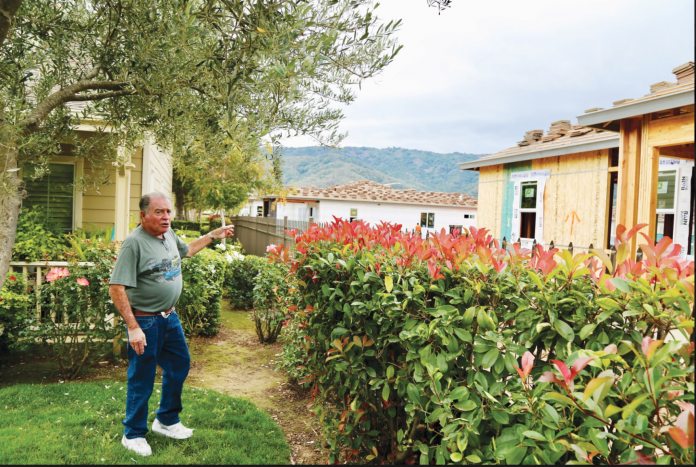Jerry and Janet Larner bought their dream house for $460,000 in 2004, a 1,200-square-foot bungalow with a view of flowery fields and green hills along Hecker Pass they hoped to live in for the rest of their lives.
They knew the picturesque open space behind them would eventually be developed—that’s the way things go in Gilroy—and when they heard the Meritage Heartland Estates project of 48 houses behind them were only one story high, they were relieved.
Then, a year and a half ago, they saw the birth of the monstrosity: a 2,700-square-foot-behemoth with a pyramid-shaped roof less than 20 feet away, blocking the views from their windows and overshadowing the olive tree in their front yard.
“They built this with no regard for us,” said Janet Larner, 74, a real estate agent. “We are the outhouse and they are the Luxor. The city sold us out completely.”
Added neighbor Jack Daley: “They assured us they would be single-story but if you build a single story house with a two-story roof, what’s the difference?”
The Larners say there is a message for voters in their problem: you can’t trust the government to look after residents and that Measure H, the urban growth boundary which would require big housing projects outside the boundary to be voted on by residents, is a good idea.
City Councilwoman Terri Aulman begs to differ. She has wrestled with the problem every day—she also lives in Village Green, although she was unable to vote on the development because it would have been a conflict of interest.
As annoying as the project is, she said, it complies with the laws and the developer has done everything the city asked it to to provide needed housing for the community.
“There were no backroom deals, no untoward activity that gave a benefit to this developer,” she said. “We did everything we could to make sure the developer did what was required.”
However, she said she sympathizes with the Larners and the other homes on the western border of Village Green.
“I didn’t expect the houses to be so close,” Aulman said. “I drove in yesterday from the Rosette gate and it looks like that house is coming in right on top of them. I feel their pain. I try to work with them as best I can. I know what I’ve been though and I know it’s worse for them.”
It will be better when a fence is put in, she said. “You’ll just see the top of the house.”
One of the problems for residents of the 62-and-over community has been a year and a half of hammering and trucks and boom boxes playing loud music, as the homes go up. The Larners said the construction used to begin at 6 a.m., an hour before it was permitted, but repeated calls to the city got that changed.
“But now at the stroke of 7 a.m., we get woken up by the beep beep beep of the trucks behind us,” said Jerry Larner, 72, a retired firefighter.
The Larners and neighbors have asked for a six-foot sound wall to block off the new homes, but the developer is only putting up a wooden one, something else that frustrates them.
Aulman lives on the other side of the project, right in front of road construction for the new roundabout on Santa Teresa, so she has been affected by noise from both sides. But, she added, it’s part of the valley’s growth.
Homes in San Jose, along Cottle Avenue and other developments are closer together and uglier, she said.
“Land is at a premium in Silicon Valley,” she continued. “They try to get more houses on less land. It’s a whole new philosophy, with mass transit and centralizing people.”
Heartland Estates was developed by Skip Spiering, the same developer who proposed the controversial 4,000-unit housing project on the 721 acres north of town.
“All I can tell you is these are single-story homes,” said Spiering. He said that they top off at 20 feet high, where a two-story would be 26-30 feet. The city requires homes to be 20 feet from the fence line, but makes an exception for patios. The patio on the house that borders the Larners is 14 feet from the fence and the base of the house is 29.3 feet from it.
Meritage Homes, which is building 503 homes in Hecker Pass, has paid the city more than $6 million in “public benefit” fees for a 4-acre neighborhood park and new traffic improvements at critical intersections.
The new homes sell for $871,000 to $943,000. The Larners say that if the developer would give them their home’s appraised $513,000 value and pay for a moving truck, they’d take off right away.














